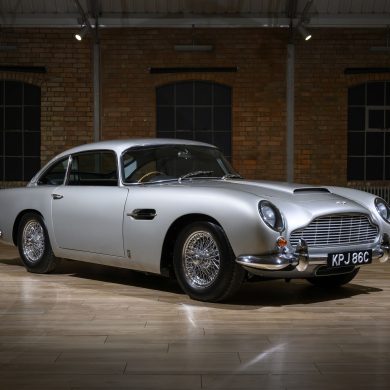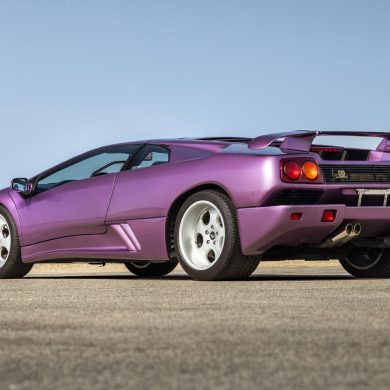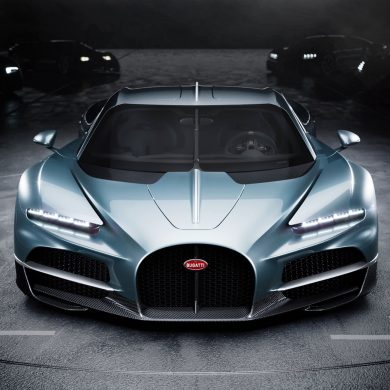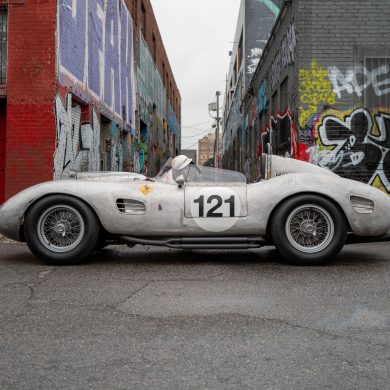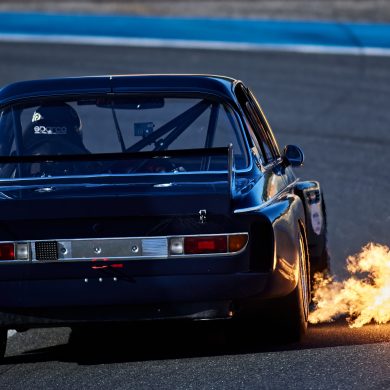While much of the Monterey Car Week, as well as the Pebble Beach Auction, is focused on vintage and classic cars, it is also where manufacturers can bring out their exclusive, limited production, or revolutionary vehicles. 2021, however, was a little bit more special for some manufacturers than others.
Every year, more and more companies are jumping on “The Green Promise,” an unofficial, undocumented move in the automotive industry to replace all gas-powered cars in the next 20 years with electric vehicles. While some manufacturers are taking a more measured approach, such as General Motors and Toyota, due to the size of their sales base and sub-brands, many other manufacturers are promising fully-electric vehicles by 2030.
What this ultimately means is that this year at Monterey, at least one manufacturer announced their final gas-powered vehicle, and a couple of others announced their hybrid-gas powered cars as the first step towards complete electrification.
Bugatti Bolide
Held at the Quail Lodge & Golf Course, the Quail: A Motorsports Gathering is an event steeped in history. Everything from the latest Scuderia Cameron Glickenhaus SCG007 Le Mans Hypercar to pre-War sports cars are on display in an exclusive setting, with very limited tickets available for sale, and half of the guests being invite-only. This exclusive, and it must be said wealthy, crowd was the perfect place, then, for Bugatti to announce their final gas-powered car, the Bolide.
It was the perfect place because while Bugatti hypercars are not what one would consider being affordable, the Bolide was able to raise more than a few eyebrows with its estimated $4 million USD price tag. And it isn’t even road legal.
The Bolide is the result of the Volkswagen ownership group handing a blank check over to Bugatti designers, engineers, and test drivers to make the most extreme, most pure-blooded time attack monster that they could. It’s so radical and out-of-the-box for the luxury brand that they have dubbed it an experimental car, and it’s not hard to see why.
The only part of the car that is even remotely similar to any of the Chiron’s and Veyron’s that have come before is the massive 8.0L W16 quad-turbo engine. And even that has been through a redesign, with a specially designed intake that gulps in twice as much air as a Chiron, and straight piped exhaust that has optimized choke points, not valves, to give optimal back pressure for the turbos. The result is what Bugatti proudly claims as Dual-1850, or 1,850 PS (1,826 HP) and 1,850 Nm (1,365 lbs-ft) of torque.
Being, in essence, a no-restrictions race car, the Bolide is also made of pretty much nothing other than carbon. The body, the monocoque, the chassis, even the suspension wishbones are all made of various forms of carbon-fiber, 3D printed carbon composite, and carbon-titanium weave. What little metal there is, is of aeronautical quality for the highest tensile strength and the lowest weight. The car, ready to race without the driver in, weights just 1,240 kg (2,733 lbs).
And if the car looks different than your average road-going Bugatti, that’s because engineers from other companies under the Volkswagen umbrella that have Le Mans racing experience (read: Audi) were brought in to shape the Bolide to generate maximum downforce for unbelievable cornering and braking. As it does not have to adhere to Le Mans rules, however, it has moveable, active aerodynamic components, which work together to generate 2,600 kg (5,730 lbs) of downforce at 321 kph (200 mph).
Only 40 Bolide’s will ever be made, and as a way to celebrate the last car that they will be making that uses gas to power it, Bugatti really does know how to end an era with a statement. Going forward, as Bugatti is part of the investment group backing electric hypercar maker Rimac, they will be using that company’s electric hypercar drivetrains for their future vehicles.
Aston Martin Valhalla
This is a car that many were surprised to see at the Quail, and it technically wasn’t there, with the display model being a shell without an engine. The surprise was because, after the tumultuous years that Aston Martin has had dancing with bankruptcy, it was believed that the Valhalla had all but been canceled in favor of the Valkyrie hypercar. Yet, it seems that with billionaire Lawrence Stroll leading an investors group, hundreds of millions of dollars and a Formula 1 team seems to be getting things back on track, with the Valhalla being announced at The Quail as a 2024 model.
With new CEO Tobias Moers, under the direction of Chairman Stroll, Aston Martin ditched the original plan of a 3.0L twin-turbo Aston Martin V6 with a KERS system in favor of a 4.0L twin-turbo Mercedes-Benz M178 LS2 with a modern Formula 1 style hybrid system to generate 1,000 HP. The rear wheels will be driven by the engine, as well as one hybrid assist motor, while the front wheels will be driven by another hybrid motor. Where the modern F1 hybrid technology comes to bear is in what is known as the MGU-K and MGU-H generator systems being on the Valhalla.
MGU-K stands for Motor Generator Unit – Kinetic and will be what most hybrid supercars and hypercars already use, regenerative braking to charge up a supercapacitor battery pack. The Motor Generator Unit – Heat (MGU-H) is where the tech goes next level, with a small electric generator attached by a shaft to each turbocharger. When the engine is used to accelerate, the turbo turbines spin and both compress incoming air to the engine as well as charge the battery pack. However, if the engine falls outside of optimal turbo range when the accelerator is pressed, for example exiting a corner, the generator becomes a motor, dumping captured energy back into the turbo to spin it up, preventing any chance of turbo lag.
On a Formula 1 car, this has enabled over 50% of the power generated by each combustion cycle in the engine to be captured and used, and it is hoped that the engine in the Valhalla will be able to come close to 35 to 40% capture and use.
Lamborghini Countach LPI 800-4
Although Lamborghini announced earlier this year that the Aventador Ultimae would be their final V12 gas-powered supercar, it seems they snuck in one special edition in as well! The LPI 800-4 is an homage on the 50th anniversary of the launch of the original Countach, and uses the supercapacitor hybrid technology that first debuted on the Lamborghini Sian.
Built on the underpinnings of the Sian, the Countach will have a 6.5L L539 V12 engine, the same model as used in the Ultimae, with 775 HP. This will be assisted with the supercapacitor 48-volt hybrid drive system from the Sian, which will provide a peak of 35 HP, and is a small motor mounted inside the 7-speed transmission. This hybrid assist is designed to be used for hard acceleration, keeping the power going to the wheels during up-shifts and helping launch the car from a standstill. With this assistance, the Countach LPI 800-4 has a stated 0 to 60 time of 2.75 seconds.
As the original Countach was powered by a L112 V12 engine, only 112 of the new Countach are going to be made. And if you were hoping to snag one, too late. They were offered to preferred customers, and all are sold already. However, fret not, as there are still likely to be V10 and V8 hybrid models coming in the future, before Lamborghini as well goes fully electric.
Acura NSX Type-S
For possibly the first, and maybe the last, time, Honda will be selling the majority of a special edition of one of their sports cars in North America. The second-generation Honda NSX is slated to finish production in late 2022, and as part of that winding down, the last 350 cars produced will be of the special edition Type-S variant. Of those, 300 are slated to come to North America, with 50 going to the rest of the world, and surprisingly, none will be sold in Japan, since the NSX was discontinued there in 2020.
As high-end Honda cars are sold under the Acura sub-brand in North America, that is why the car has been announced as the Acura NSX Type-S. It boasts multiple special parts over its “normal” version, including the larger twin turbochargers that are used on the NSX GT3 Evo race car, which will bump pure engine power from the 3.5L twin-turbo V6 from 500 HP to 520 HP. The three-motor hybrid system, one motor per wheel up front and one axle-drive motor in the rear, has also been retuned and reprofiled to produce 80 HP of assist vs the normal 73 HP. This gives the NSX Type-S a combined output of 600 HP, 27 more than its normal 573 HP.
One of the biggest new features of the Type-S is the rapid-downshift 9-speed dual-clutch transmission. While regular upshifts and downshifts will occur 50% faster than on the base NSX, rapid-downshift will automatically downshift the gearbox to the optimal available gear with a half-second paddle pull far faster than manually requesting each downshift, while also blipping the engine to rev-match to exactly where the transmission will land.
Other features are an increase in the use of carbon-fiber, a reprofiled, more-track-oriented rear end derived from the GT3 Evo race car, newer battery technology that is lighter and stores just as much power, and a new Lightweight Package option. The package offers a savings of 58 lbs over the already lightened Type-S, through the use of carbon-ceramic brakes, a carbon composite engine cover, and replacing multiple interior surfaces with carbon fiber trim.
As part of their presentation at The Quail, Honda also announced that they are not abandoning the supercar segment of the market. There were hints dropped, some subtle, some not so, that the next Honda supercar will be fully electric, as Honda engineers did aid with technology development for the next, all-electric Corvette supercar, the C9.

















